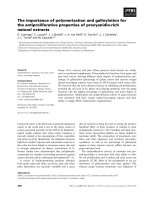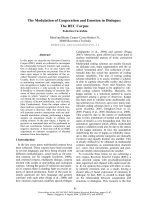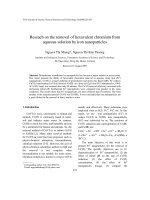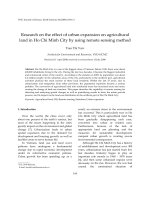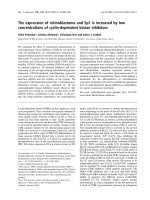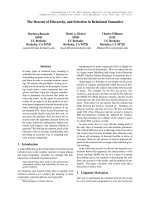BÁO CÁO "RESEARCH ON THE CHANGE OF 2-AP AND OTHER VOLATILE COMPOUNDS IN PROCESSING BUN FROM RICE" doc
Bạn đang xem bản rút gọn của tài liệu. Xem và tải ngay bản đầy đủ của tài liệu tại đây (384.67 KB, 8 trang )
J. Sci. & Devel., Vol. 10, No. 5: 730 - 737
Tạp chí Khoa học và Phát triển 2012 Tập 10, số 5: 730-737
www.hua.edu.vn
RESEARCH ON THE CHANGE OF 2-AP AND OTHER VOLATILE COMPOUNDS
IN PROCESSING BUN FROM RICE
Phan Phuoc Hien
1
, J.D. Park
2
, Truong Thi Bich Lieu
1
1
Nong Lam university HCMC Vietnam;
2
Korea Food reseach Institute
Email:
Received date: 29.05.2012 Accepted date: 15.09.2012
ABSTRACT
Vermicelli is the traditional dish of Vietnam which is the main material to prepare “Hue Beef rice vermicelli” (Bun
bo Hue), a very famous specialty originated from
Hue city, the former imperial capital of Vietnam. Flavor and taste are
important attributes of vermicelli. This study was carried out to determine the change in 2-AP and other volatile
compounds as influenced by different durations of soaking rice in water during vermicelli processing. In order to
identify and quantify the amount of 2-AP and other volatile compounds 2-AP extracted from pandan leaves was used
as standard. Results indicated that 2-AP and other volatile compounds clearly changed in the vermicelli processing
process and soaking for 12 hours was recommended.
Ke
ywords: Rice vermicelli, 2- Acetyl - 1 Pyrroline (2-AP), volatile compounds.
Nghiên cứu sự thay đổi cấu tử thơm 2-AP và các chất bay hơi khác
trong qui trình chế biến bún từ gạo
TÓM TẮT
Bún là nguyên liệu chính để chế biến “Bún Bò Huế”, đây là một món ăn đặc sản của Việt Nam có nguồn gốc từ
thành phố Huế, trước đây là kinh đô của Việt Nam. Hương vị đặc trưng của sợi bún quyết định tới chất lượng bún
sản phẩm. Để làm rõ những sự thay đổi này, đề tài nghiên cứu đã tiến hành chiết xuất cấu tử chính tạo nên mùi
thơm 2 Acetyl- 1 Pyrroline từ lá
dứa và sử dụng nó như là chất chuẩn để định tính và định lượng sự thay đổi này bao
gồm cấu tử chính 2-AP và các cấu tử bay hơi khác trong gạo ngâm nước theo quy trình chế biến bún truyền thống.
Kết quả chứng tỏ rằng cấu tử thơm 2-AP và những cấu tử bay hơi khác đã biến đổi một rất rõ rệt trong quá trình chế
biến này. Trên cơ sở đó đưa ra khuyến cáo n
gâm gạo trong 12 giờ quy trình chế biến bún.
Từ khóa: Bún, cấu tử bay hơi, 2 Acetyl - 1 Pyrroline (2-AP).
1. INTRODUCTION
In Vietnam, there are many rice varieties in
that the most interesting is aromatic rice (Phan
Phuoc Hien et al., 2009). The key aromatic
constituent 2-Acetyl-1-Pyrroline (2 - AP) in
aromatic rice was found out in pandan leaf
(Pandanus amaryllifolius), also existed in white
bread, and flowers (Vallaris glabra) (Varaporn
Laksanalamai et al., 1993). Due to pandan leaf
contains this specific constituent with very high
content as compared with aromatic rice (Phan
Phuoc Hien, 2011), it is often used to enhance
the appealed flavor of foods in many countries
such as Indonesia, Philippines, Malaysia,
Thailand, Vietnam and Burma, especially in
rice cooked and sweet cakes (Varaporn
Laksanalamai and Sarath Ilangantileke, 1993).
In order to develop aromatic rice production
in Viet Nam, reliable and practical methods to
assess 2-AP and other volatile compounds in
aromatic rice are required to evaluate and select
the better varieties. In response to this demand,
during the past 7 years, two modern methods
have been fitted up and operated at the
Physiochemical laboratory in Nong Lam
University, Ho Chi Minh City, Vietnam. The first
is Solid Phase Micro-Extraction coupling with
Gas Chromatography (SPME/GC) and Mass
Spectrometry (SPME/MS), and the second is SDE
(Simultaneous Distillation Extraction) also
730
Research on the Change of 2-AP and Other Volatile Compounds in Processing Bun from Rice
coupling with GC and GCMS. SPME/GC enables
for estimation of 2-AP low concentration like
aromatic rice. The SDE method is suitable for
extraction of the 2-AP high concentration
materials like Pandan leaf (Phan Phuoc Hien,
2011). Based on the two methods we studied for
extraction and quantitative analysis of 2-AP in
the pandan leaf and used it as the standard for
qualitative and quantitative analysis of 2-AP in
aromatic rice and other medicinal plants such as
Thien Nien Kien Homalomena aromatica (Phan
Phuoc Hien et al., 2011).
In the process of vermicelli strands (Bun)
prepared from rice, step of soaking rice in water
with different duration definitely influences on
quality and flavor for the end-product “Bun”. In
reality, this step made change biochemical
properties of rice material leading to finally
change 2-AP and other volatile compounds in
rice. In order to demonstrate clearly these
changes, SDE and SPME coupling with GC-FID
and GCMS were used to identify, quantify and
presented in this paper.
2. MATERIALS AND METHODS
2.1. Materials
The pandan (Pandanus amaryllifolius)
leaves (Fig. 1) were used to extract 2-AP as
standard. Rice materials include two varieties
from Vietnam, OM 6162, Khao Dawk Mali
(KDM) and two varieties from Korea,
Chuch
eong variety (milled rice), and Black rice
(mixture of several varieties).
Pandan leaves (collected from Di An District, Binh Duong,
Vietnam) are classified into 3 types:
old leaf (a), young leaf (b), and mature leaf (c)
Fig 1. Three types of Pandan leaves: old
leaf (a), young leaf (b), and mature leaf (c)
For the identification and quantification
of change in 2-AP and other volatile
compounds, milled rice of KDM was soaked in
water for 12 and 48 hours; non-soaked rice
served as control.
2.2. Extraction methods
a. Simultaneous Distillation-Extraction (SDE)
The steam distillation-solvent extraction
was used as a reference for 2AP and other
volatile compounds quantification. Extraction
was performed using Godefroot apparatus
(Godefroot et al., 1981) on 20g of brown rice
with dichloromethane as solvent and collidine
as internal standard. Duration of extraction was
30 minutes from apparition of the first drop of
water in the bottom of the condensed tube.
Volatile compound extracts were then
concentrated to 0.3 ml by drying under a
nitrogen flow at room temperature and stored
at -18°C prior to GC/FID and GCMS analysis
(Phan Phuoc Hien et al, 2009; 2010; 2011).
b. Solid Phase Micro Extraction (SPME)
Extraction of volatile fractions in rice was
performed by using a Supelco
®
VB/Carboxen/PDMS (divinylbenzène/ Carboxen/
polydiméthylsiloxane) fiber 3.5 g of milled rice
with 500 µl of water were placed in a 10 ml vial.
As for rice samples analysed by SPME-GC,
collidine was added as an internal standard.
The solution was equilibrated at 80°C for 5
minutes then the fiber was introduced in the
headspace surrounding rice at the same
temperature for 15 minutes (Phan Phuoc Hien,
2009; 2010; 2011).
2.3. Analysis methods
a. Quantification of 2AP concentration by
GC-FID
a b c
T
he extracts obtained by the SDE and
SPME were analysed by using a Hewlet
Packard 5890 Series II gas chromatograph with
a flame ionisation detector (GC-FID). The
column was a non-polar DB-5 (J&W Scientific)
capillary column (length 60m, 0.32mm, film
731
Phan Phước Hiền, J.D. Park, Trương Thị Bích Liễu
732
thickness 0.25 µm). Helium was used as carrier
gas at a flow rate of 1.9 ml/min at 25
0
C. The
injection was performed in splitless mode first
(5 min for SPME and 2 min for SDE), then in
split mode to the end of the cycle (38.5 min for
SPME and 70 min for SDE). After warming the
column at 40
0
C for 5 minutes, the following
temperature programs were applied:
- For SD
E: from 40
0
C to 220
0
C at a rate of
3
0
C/min and finally maintained at 220
0
C for 5 min;
- For SPME: from 40°C to 115°C at a rate of
3°C/min then from115°C to 220°C at 30°C/min
and finally maintained at 220◦C for 5 min. The
detector port was maintained at 250
0
C.
Concentration of 2-AP in samples s is identified
and quantified in the 3.1 section in this paper.
b. Volatile compounds analysis by SPME
coupling with Mass Spectrometry (SPME-
MS)
Fig 3. Ad
sorption phase in SPME extraction
injector temperature were respectively
maintained at 260°C and 250°C. He at 2 ml/min
was the carrier gas. The column was
maintained at 220°C for 15 min. Source
temperature was 150°C and the mass spectra
were scanned at 70 eV in the m/z range from 40
to 200 at 8.17 scans/second. The global signal
registered between 2.8 and 10 minutes was
transformed by using the Pirouette
®
software.
SPME fib
er was directly introduced in the
GC/MS injector operating with splitless mode
for 4 minutes at 250°C. An Agilent 6980 gas
chromatography equipped with a DB-WAX
fused silica capillary column (60 m 0.25 mm
d.i.; film thickness = 0.25 µm) coupled with a
Agilent 5973N mass spectrometer was used for
the GC/MS analysis. The transfer line and the
3. RESULTS AND DISCUSSION
3.1. Extraction, identification, and
quantificat
ion of 2-AP in Pandan leaf
In this experiment, response factor (RF) of
collidine has been used to identify and quantify
2-AP in pandan leaf that was extracted by SDE
and then analyzed by GC-FID. By this method,
retention time (Rt) of collidine and 2-AP in
pandan were detected at 12.936 minute and
9.498 minute respectively wherein this 2-AP
will be used as a standard to identify and
quantify 2-AP in aromatic rice (Phan Phuoc
Hien, 2009; 2010; 2011).
Quantification of 2-AP in pandan leaf:
Content of 2 - AP in pandan leaf extracted
by SDE was calculated as follows:
Fig 2. Syst
em of the SPME extraction
Research on the Change of 2-AP and Other Volatile Compounds in Processing Bun from Rice
Figure 4. GC-FID chromatograph of 2-AP and other volatile compounds in pandan leaf
[2 - AP]
SDE
(g/kg) = , in which:
- A: Area of the 2 - AP peak
- RF: Response factor under the external
standard collidine
- d: diluted concentration of sample
- m: sample mass analyzed (kg)
The peak areas were quantified as table 1.
RF of 2 - AP was calculated under the external
standard collidine as follows:
RF
collidine
=
01.1
14009069
= 1400906900 (pA*s/µg).
Whereby collidine mass injected into
GCFID was 0.01 µg. By this way, 2-AP content
of the pandan leaves was quantified (Table 2).
Table 1. Peak areas of collidine and 2-AP in pandan leaves
recorded by GC-FID and GCMS
Samples Peaks’areas (pA*s)
Collidine 14009069
2-AP in young pandan leaf 58157862
2-AP in mature pandan leaf 20672313
2-AP in old pandan leaf 31776315
Table 2. Content of 2 - AP (ng/kg) in the pandan leaves quantified by SDE-GCFID
Pandan leaves Content 2 - AP (ng/kg)
Young pandan leaf 2.07572
Mature pandan leaf 737.818
Old pandan leaf 1.134134
Collidine
12.936min
2 – AP
9.4
98 min
733
Phan Phước Hiền, J.D. Park, Trương Thị Bích Liễu
3.2. Identification of 2-AP in Korea rice
varieties
By SPME coupling with GC-FID, rice
samples from Korea were extracted and analyzed
by the same conditions as described above.
The analytical results showed that there is
no 2-AP peak in the Korea rice samples at the
Rt (9.498 minute) as the 2-AP peak of Pandan
leaf. It means that the Korea rice varieties are
not aromatic (Fig 5).
No peak 2-AP
at the 9,498 mins
Fig 5. Volatile compounds in Chucheong rice from Korea recorded
by GC-FID showed that it has no peak 2-AP at the Rt 9.498 minute
3.3. Identification of 2-AP in OM rice from
Cuulong Rice Research Institute, Viet Nam
GC-FID chromatograph of OM 6162 variety
recorded in Figure 6 showed that OM 6162 is
an aromatic rice variety because its peak 2-AP
was identified clearly at the Rt 9.678 minute.
2-AP
Fig 6. SPM
E/GC-FID chromatograph of OM 6162
exposed the peak 2-AP at the Rt 9.678 minute
734
Research on the Change of 2-AP and Other Volatile Compounds in Processing Bun from Rice
3.4. Investigating the changes of 2-AP and other volatile compounds of rice in Bun
processing
Table 3. The volatile compounds in non-soaking and 12 hours soaking
of Khao Dawk mali recorded by GCMS
N
0
12 hours water soaking Non-soaking
1 1 - butanol 0
2 hexanal hexanal
3
1- hexanol ethanone, 1-(2-methyl-1-cyclopenten-1-yl)-
4 2- heptanone
ethylbenzen
5 heptanal
1-hexanol
6
2- acetyl -1- pyrroline 1-nonanol
7
benzaldehyde 2- acetyl -1- pyrroline
8
1- heptanol 1- heptanol
9
1-octen-3-ol 1-octen-3-ol
10
2 -pentyl-furan 2 -pentyl-furan
11
butanoic acid, butyl ester 5-hepten-2-ol,6-methyl-
12
octanal octanal
13 2-heptenal
tetradecane
14 benzeneacetaldehyde benzeneethanol, -dimethyl-
15 butanoic acid, 3-methylbutyl ester
1-hexanol,2-ethyl-
16 2-octenal
2-octen-1-ol
17 ethanone, 1-(1H-pyrrol-2-yl)- ethanone, 1-(1-cuclohexen-1-yl)-
18 2-octen-1-ol 0
19 1-octanol 1-octanol
20 2-nonanone
21 propanoic acid, 2-methyl-, pentyl ester 5,9-undecadien-2-one,6,10-dimethyl-
22 2-nonanol tetradecane,2,6,10-trimethyl-
23 nonanal nonanal
24 2,4-pentanedione, 3-butyl- 0
25 3-nonen-1-ol 0
26 cyclohexanone, 5-methyl-2-(1-methylethyl)- cyclohexanol, 1-methyl-4-(1-methylethyl)-
27 2-nonenal
2-undecanone,6,10- dimethyl-
28 1-nonanol
29 not available in NIST libray of GCMS Not available in NIST libray of GCMS
30 dodecane dodecanal
31
decanal decanal
32
phenol,4-ethyl-2-methoxy- 0
33
2-decenal 2-decenal
34
butanoicacid, heptyl ester 0
35
2-undecanone 2-undecanone
36
undecanal undecanal
37 pentadecanone, 6,1,14-trimethyl- 2-pentandecanone,6,10,14-trimethyl-
38 n-hexadecanoicacid 0
735
Phan Phước Hiền, J.D. Park, Trương Thị Bích Liễu
Notes:
(1) Blue line: (control treatment)
(2) Green line: soaked 1 night
(3) Red line: soaked 2 days
(1)
(2)
(3)
Fig 7. GC
-FID chromatograph found out the change of 2-AP and other volatile compounds
in three treatments: KDM not to be soaked, to be soaked for 8 hours, and for 2 days.
Table 4. The change of 2-AP content in KDM rice
with different soaking durations in Bun processing
No
Treatment
(KDM rice sample)
Rice sample mass (g) Area of 2-AP (pA*S) 2-AP content (ppb)
1 Rice not soaked in water 1.5030 21.8000 2.439731
2 Rice soaked in water 12 hours 1.5029 14.7000 1.664187
3 Rice soaked in water 48 hours 1.0500 0.0000 0.000000
The purpose of this study is to demonstrate
the change of 2-AP and other volatile
compounds in vermicelli processing from rice.
Aromatic rice variety Khao Dawk Mali as
confirmed by analysis results with SPME-
GCMS was used in the experiment and three
treatments were employed as follows:
(1) Rice KDM is not soaked in water
(Control treatment)
(2) Rice KDM is soaked in water for 12 hours
(3) Rice KDM is soaked in water for 48 hours
The amount of 2-AP was identified and
quantified in both control and treatments. The
key aromatic constituent 2-AP still retained
after 12 hours soaking of rice but slightly
decreased. 29 volatile compounds were
detected in the control treatment as compared
to 38 volatile compounds when soaked for 12
hours (Table 3) It means that after 12 hours
soaking rice in water 9 new volatile compounds
were produced, viz. 1 - butanol, 2-octen-1-ol,
2,4-pentanedione, 3-butyl, 3-nonen-1-ol,
phenol, 4-ethyl-2-methoxy, butanoic acid,
heptyl ester, n-hexadecanoic acid, 1-nonanol,
and 2-nonanone (Table 3). These changes
influenced by duration of soaking created new
flavor for the end-product.
In contrast to soaking for 12 hours, soaking
KDM in water for 48 hours (or two days) ,
736
Research on the Change of 2-AP and Other Volatile Compounds in Processing Bun from Rice
resulted in nearly complete loss of 2-AP and
other volatile compounds. The qualitative
results recorded by GCMS and quantitative
results are presented in Figure 7 and table 4,
respectively. This might be attributable to the
accompanied fermentation process due to long
duration soaking.
4. CONCLUSION
By SDE extraction method and use
response factor of collidine, 2-AP from pandan
leaf was extracted, identified and quantified by
GC-FID, GCMS and used as a standard to
identify and quantify 2-AP in aromatic rice and
its change during vermicelli processing. Based
on this method, only cultivar OM 6162 from
Cuu long Delta Rice Research Institute and
KDM from the institute of agriculture south
were identified as aromatic rice.
Different soaking durations clearly change
2-AP and other volatile compounds. Soaking
rice for 12 hours increased the volatile
compounds (38) as compared to the control (29)
The 9 new volatile compounds were 1 - butanol,
2-octen-1-ol, 2,4-pentanedione, 3-butyl, 3-
nonen-1-ol, phenol,4-ethyl-2-methoxy, butanoic
acid, heptyl ester, n-hexadecanoic acid, 1-
nonanol, 2-nonanone and these produce new
flavor and specific attribute to the end product.
The 2-AP amount was 1.664.187 ppb when
soaked for 12 hours and decreased by 31.79%
as compared to the control However, if rice
soaked for 48 hours 2- AP and many other
volatile compounds were reduced or completely
lost. These might be explained by biochemical
fermentation process in natural conditions.
REFERENCES
A.B.Nadaf, S. Krishnan và A.K.Watke (2006)
Histochemical and Biochemical analysis of major
aroma compound (2-acetyl-1-pyrroline) in bastami
and other scented rice (Oryza Sativa L.). Current
science, vol 91, No. 11, 10 december 2006. pp.
1533-1536
Chang T.T & Somrith B. (1979). In chemical aspects of
rice grain quality. IRRI, Manila, Philippines. pp.
49-58.
Grimm Casey C., Christine Bergman, Janis T. Delgado, and
Rolfe Bryant (2001). Screening for 2-acetyl-1-
pyrroline in the headspace of rice using SPME/GC -
MS. J. Agric. Food Chem 49. p. 245-249.
Ph
an Phuoc Hien (2009). Méthodes d’analyse et
d’expérience biochimique moderne,
(Perfectionnement à l’Ecole Nationale Supérieure
d’Agronomie et des Industries Alimentaires-
ENSIASA, Institut National Polytechnique de
Lorraine-INPL), France (2005), Published by
Agricultural Publishing House Ho Chi Minh City
Vietnam.
Pha
n Phuoc Hien, Do Khac Thinh (2009). Research on
the change of quality and aroma in mutant rice
breeding induced by gamma irradiation, Nuclear
Science and Technology, No.3, published by
Vietnam Atomic Energy Society, ISSN 1810-5408,
September 2009. pp. 40-49.
Phan Phuoc Hien (2010). Méthode d’analyse des
arômes du riz. CIRAD France (2005), Agricultural
House Ministry of Agriculture and Rural
development (MARD) Vietnam.
Phan Phuoc Hien, Truong Thi Bich Lieu (2011).
Research on the extraction and utilization of 2-AP
from Pandanus’leaf as the standard for
identification and quantification of 2-AP in
aromatic rice, Conference proceeding of the 2
nd
analytica Vietnam 2011, Ho Chi Minh City 07-08
/5/2011, pp. 172-180.
Phan Phuoc Hien, Truong Thi Bich Lieu, Tran Van
Ton (2010). Extraction and utilization process of 2-
AP fromPandanus’leaf as the standard for
identification and quantification of 2-AP in
aromatic rice, Tạp chí Khoa học Nông Lâm nghiệp
ISSN: 1859-1523 số 4/2010, trang 120-127.
Phan Phước Hiền, và ctv ( 2011). Nghiên cứu bước
đầu đặc điểm sinh học và thành phần hóa học tinh
dầu của các loài thiên niên kiện tại Vườn Quốc gia
Côn đảo. Tạp chí Khoa học Kỹ thuật Nông Lâm
Nghiệp, số 4/2011, trang 21-27.
Varaporn Laksanalamai and Sarath Ilangantileke
(1993). Comparision of aroma compound (2-
acetyl-1-pyrroline) in leaves from Pandan
(Pandanus Amaryllifolius) and Thai fragrant rice
(Khao Dawk Mali 105). Cereal chemistry, vol 70,
No. 4, pp. 381-384.
737


